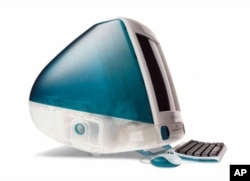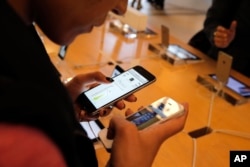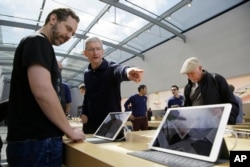Practical, yet psychologically and aesthetically pleasing. That duality helped make Apple computers the most distinctive computers in the world — and helped change the look of the technology we take for granted today.
From the very beginning of Apple Inc. in 1976, co-founder Steve Jobs was as concerned about the appearance of the computers as he was about the utility. In that sense, he was a true visionary.
According to a former company vice president, Don Norman, Apple has never been a hardware company or a software company. It is a systems company, for which the smooth integration of hardware and software was most important.
"There was always this concern for making things attractive, beautiful, enjoyable and completely understandable," said Norman, now director of the Design Lab at the University of California-San Diego.
Jobs never finished college, but at one point took a course in calligraphy — which may have influenced the way he looked at everyday objects, because the art of beautiful handwriting teaches about the importance of the smallest details.
The first radical change
In 1998, Apple computers were already known and admired around the world. In August of that year, Jobs unveiled a product that was visually different from any computer anyone had ever seen.
The iMac G3 was a desktop computer with its hardware, CRT monitor and high-quality speakers integrated into one semi-translucent body with rounded edges. It came in 13 colors.
Before Apple, says Daniel Martinage, executive director of the Industrial Designers Society of America, American computer design was mostly beige.
"After Apple, it became more colorful, it became more user-centered, it became cool, it became more European-like," he said.
Indeed, there was a strong European influence. iMac G3 was the result of a new consumer-oriented strategy that Jobs developed with British-born industrial designer Jonathan Ive. Ive was strongly influenced by German industrial designer Dieter Rams, the chief designer of the German consumer products company Braun.
Jobs and Ive decided that a personal computer had to do more than just compute. As Martinage puts it: "They were designing products that they themselves wanted to use."
Handheld devices
Jobs and his team had an excellent understanding of what the public wanted before the public was aware of it.
In 2001, as portable music players — commonly known as MP3 players — became increasingly popular, Apple unveiled its first successful handheld device, the iPod. With rounded edges and a smooth finish, it was comfortable to hold in your hand and easily slipped into and out of a pocket or purse. It did not require a stylus, and could be operated with one hand.
It instantly became a must-have for many.
Expanding on the concept of enhancing the user experience, that same year, the company began releasing products in its newly dedicated Apple stores. Visitors and buyers could play with fully working desktop and laptop computers, watch video clips and listen to music through earphones. Even handheld devices could be tested. Knowledgeable staff offered advice and answered questions.
Apple also started focusing on packaging as part of the product.
The University of California's Don Norman says the boxes that Apple's products came in were so well-designed that consumers often found it hard to throw them away.
"Apple transformed the opening of the box to be a part of the whole sale," Norman explained. "Apple makes the box attractive. Apple makes it wonderful. When you open it, you don't see instructions, you don't see CD-ROMs and stuff. You see the device."
Game-changer
Handheld devices were a huge success, but for Jobs, buttons were still clunky and their function could not be changed. The company's designers embraced a revolutionary new technology — the touch-sensitive screen. First introduced in the pocket media player iPod Touch, the real game-changer came in 2007 with the iPhone.
Within 15 months, Apple sold more than 1 million iPhones, and the industry entered a new era as manufacturers were forced to follow Apple's example.
Norman says Apple's products changed the computer industry's way of thinking.
"It said, 'Hey, technology doesn't have to be ugly, doesn't have to be stuck away, hidden somewhere,'" he said.
And that new approach applied not only at home, but in the office, too.
"After all," Norman observed, "an office worker is a person, and the same kind of things they want for their home — why not on their desk and in their work environment?"
Looking forward
Jobs died in 2011 after a long battle with cancer. But the company continues to grow, moving steadily on the course that he and his co-founder, Steve Wozniak, set it on 40 years ago.
There are a lot of exciting things happening that continue to push the needle within the industry and around product design, Martinage says.
"The iPhone, for example, is the number two phone in China,” he said. “So there's a whole other market out there that is still being developed. You can't underestimate the impact Apple has had on the design world, in terms of just bringing design — product design — front and center."
It wouldn't be fair to say that Apple was the most significant thing within the industrial design profession but, Martinage adds, it certainly was one of the big ones.



